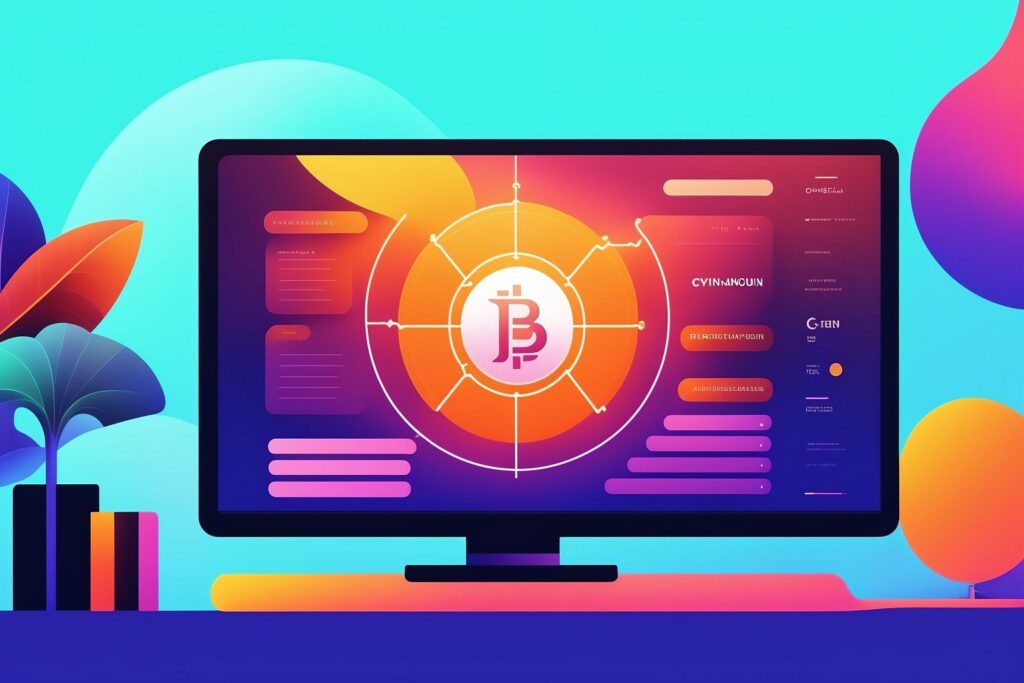Introduction
Ethereum is a decentralized blockchain platform that enables developers to create their own decentralized applications (dApps). One of the most popular use cases for Ethereum is creating digital tokens. Ethereum allows anyone to create their own cryptocurrency on its blockchain. These tokens can represent assets, utility, or even currencies.
If you’re interested in creating a token on the Ethereum network, this guide is for you. In this article, we will take you through the basic steps and requirements for creating a token on the Ethereum network.
1. Why Create a Token on the Ethereum Network?
The Ethereum network is a blockchain-based decentralized platform that enables developers to create smart contracts and decentralized applications (DApps). One of the key features of Ethereum is the ability to create and deploy custom tokens on its blockchain.
a. Benefits of Creating a Token on the Ethereum Network
There are several benefits to creating a token on the Ethereum network, including:
- Decentralization: Ethereum is a decentralized platform, which means that no single entity or authority controls the network. This provides greater security and transparency, as transactions are verified by a network of nodes instead of a centralized party.
- Compatibility: Ethereum tokens are compatible with most cryptocurrency wallets and exchanges, which makes it easier for users to buy, sell, and trade them.
- Customization: Tokens on the Ethereum network can be customized to suit a variety of use cases, such as governance tokens for decentralized organizations, utility tokens for DApps, and security tokens for regulated assets.
- Interoperability: Ethereum tokens can interact with other tokens and smart contracts on the Ethereum network, which enables more complex transactions and use cases.
b. Use Cases for Ethereum Tokens
Ethereum tokens have a wide range of use cases, including:
- Utility tokens: These tokens are used to access and utilize a particular DApp or platform.
- Security tokens: These tokens represent an asset or investment, such as equity in a company or ownership of real estate.
- Governance tokens: These tokens allow holders to vote on decisions related to the operation of a decentralized organization.
- Stablecoins: These tokens are pegged to the value of a stable asset, such as the US dollar or gold, and are designed to minimize volatility.
- Non-fungible tokens (NFTs): These tokens represent unique digital assets, such as art, music, and collectibles.
Overall, creating a token on the Ethereum network provides a powerful tool for developers and businesses to create custom digital assets and decentralized applications that can operate in a secure, transparent, and decentralized manner.
2. Requirements for Creating a Token on the Ethereum Network
Creating a token on the Ethereum network requires several essential components, including an Ethereum wallet, Ether (ETH), Solidity programming language, and a basic understanding of smart contracts.
a. Ethereum Wallet
An Ethereum wallet is a software program that stores public and private keys and interacts with the Ethereum network. It allows users to send and receive Ether and other Ethereum-based assets such as tokens. To create a token on the Ethereum network, a user must have an Ethereum wallet that supports the ERC-20 standard.
b. Ether (ETH)
Ether is the native cryptocurrency of the Ethereum network, and it is used to pay for transactions and execute smart contracts. To create a token on the Ethereum network, a user must have a sufficient amount of Ether to pay for transaction fees, also known as gas.
c. Solidity Programming Language
Solidity is a programming language used to write smart contracts on the Ethereum network. It is a high-level language that allows developers to create custom tokens, among other decentralized applications (dApps). Solidity is based on JavaScript and is relatively easy to learn for developers familiar with object-oriented programming languages.
d. Basic Understanding of Smart Contracts
A smart contract is a self-executing contract that contains the terms of an agreement between parties. It is stored on the blockchain and can be programmed to execute automatically when certain conditions are met. To create a token on the Ethereum network, a user must have a basic understanding of smart contracts, as tokens are implemented as smart contracts on the Ethereum blockchain.
In summary, creating a token on the Ethereum network requires an Ethereum wallet that supports the ERC-20 standard, a sufficient amount of Ether to pay for transaction fees, knowledge of the Solidity programming language, and a basic understanding of smart contracts. With these components in place, users can create their own custom tokens and deploy them on the Ethereum network.

3. Steps to Create a Token on the Ethereum Network
Ethereum is a blockchain-based platform that enables developers to create decentralized applications, including smart contracts and tokens. Tokens are digital assets that can represent anything from a physical object to a utility or security. Creating a token on the Ethereum network requires a series of steps, as outlined below:
a. Set Up a Development Environment
Before creating a token on the Ethereum network, you will need to set up a development environment on your computer. This will typically involve installing an Ethereum client, such as Geth or Parity, and a development framework, such as Truffle. You will also need to have a solid understanding of Solidity, the programming language used to write smart contracts on the Ethereum network.
b. Write Your Smart Contract
Once you have your development environment set up, the next step is to write your smart contract. This is the code that will define the rules and logic of your token. You will need to decide on the token’s name, symbol, and other parameters, such as the total supply and decimal places. You will also need to include functions for transferring and managing the token.
c. Compile Your Smart Contract
After writing your smart contract, you will need to compile it using a Solidity compiler. This will convert your code into bytecode, which can be executed on the Ethereum Virtual Machine (EVM). The bytecode is also what you will use to deploy your smart contract to the Ethereum network.
d. Deploy Your Smart Contract
With your smart contract compiled, the next step is to deploy it to the Ethereum network. This involves creating a transaction that includes the bytecode of your smart contract, which is then broadcast to the network. Once the transaction is confirmed, your smart contract will be deployed to the Ethereum network and will be live.
e. Interact with Your Token
With your smart contract deployed, you can now interact with your token using an Ethereum wallet, such as Metamask. You can transfer your token to other wallets, manage the token’s supply, and execute other functions that you included in your smart contract.
In summary, creating a token on the Ethereum network involves setting up a development environment, writing a smart contract, compiling the contract, deploying it to the network, and interacting with the token using an Ethereum wallet. With these steps completed, you can create a digital asset that is secured by the Ethereum blockchain and can be used in a wide range of decentralized applications.
4. Customizing Your Token
When creating a new cryptocurrency, it’s essential to customize the token to make it distinct and unique from other tokens. Customization includes specifying the token name, symbol, total supply, decimal places, and token standard.
A. Token Name
The token name is the title given to your cryptocurrency. It should be unique, memorable, and represent your project or company. It can be a maximum of 256 characters long and should be chosen with care as it cannot be changed later.
B. Token Symbol
The token symbol is a three to four-letter code used to represent your cryptocurrency. It should be unique and easy to remember as it will be used as a shorthand way to identify your token in cryptocurrency exchanges and wallets.
C. Total Supply
Total supply refers to the maximum number of tokens that can be created. It is a critical parameter that determines the scarcity of your token. Too many tokens in circulation can lead to inflation, while too few can restrict its usability. The total supply can be fixed or variable, depending on the type of cryptocurrency.
D. Decimal Places
Decimal places refer to the number of digits that can be used to represent fractional units of your token. It determines the minimum unit of your cryptocurrency that can be traded. Most tokens use up to 18 decimal places to represent the smallest fraction of the token, known as a “wei.”
E. Token Standard
The token standard specifies the rules and guidelines for the implementation of your cryptocurrency. It ensures that your token is compatible with existing blockchain infrastructure, wallets, and exchanges. The most common token standard is the ERC-20 standard, developed on the Ethereum blockchain, which defines a set of rules that all ERC-20 tokens must follow. Other token standards include ERC-721, ERC-1155, and BEP-20.
In summary, customizing your token’s name, symbol, total supply, decimal places, and token standard is crucial in creating a unique cryptocurrency that stands out in the crowded crypto space. Each parameter plays a critical role in determining your token’s success, so careful consideration and planning should be taken in its customization.

5. Testing and Deploying Your Token
Tokens have become an integral part of the modern digital landscape, with their widespread use in a variety of applications such as cryptocurrency, gaming, and more. However, before launching your token, it’s important to ensure that it’s properly tested and deployed to ensure its smooth functioning. This article will delve into the process of testing and deploying your token.
a. Testing Your Token
Testing your token is a crucial step in the development process, as it allows you to catch and fix any potential issues before the token is deployed to the public. Here are some important steps to follow when testing your token:
Unit Testing: This involves testing individual components or modules of the token to ensure they function correctly. This includes testing the smart contract code, wallet functions, and any other critical components.
Integration Testing: This involves testing how different components of the token interact with each other. For example, testing the communication between the smart contract and the wallet or testing the interaction between the token and a third-party application.
Load Testing: This involves testing how the token performs under heavy loads or stress. This includes testing the token’s scalability and its ability to handle a high volume of transactions.
Security Testing: This involves testing the token’s security measures to identify any vulnerabilities that could be exploited by attackers.
User Acceptance Testing: This involves testing the token with real users to ensure it meets their expectations and functions as intended.
b. Deploying Your Token
Once you have thoroughly tested your token and resolved any issues, it’s time to deploy it to the public. Here are some important steps to follow when deploying your token:
Choose a Platform: There are many different platforms that you can use to deploy your token, such as Ethereum, Binance Smart Chain, or Polygon. Each platform has its own set of requirements and considerations, so choose the one that best suits your needs.
Create the Smart Contract: The smart contract is the backbone of your token, so it’s important to create a well-designed and secure contract that meets your requirements. You can either create the contract yourself or hire a developer to do it for you.
Deploy the Contract: Once the smart contract is created, it’s time to deploy it to the blockchain. This involves paying a fee (known as gas fees) to the network to process and verify the transaction.
Test the Deployed Token: After the contract is deployed, it’s important to test the token again to ensure that it’s functioning as intended and that all the features are working correctly.
Promote Your Token: Once the token is deployed and tested, it’s time to promote it to the world. This involves creating marketing campaigns, reaching out to potential users, and building a community around your token.
In conclusion, testing and deploying your token requires careful planning and execution to ensure that it functions correctly and meets the needs of your users. By following the steps outlined in this article, you can ensure that your token launch is successful and sets you up for future growth and success.
6. Benefits of Creating a Token on the Ethereum Network:
- Decentralized
- Transparency
- Fast and Efficient
- Cost-Effective
- Secure
7. Use Cases for Ethereum Tokens:
- ICOs
- Loyalty Programs
- Voting Systems
- Digital Assets
- Gaming Tokens
- Stablecoins

8. Frequently Asked Questions (FAQs)
Q: What is the difference between a token and a cryptocurrency?
A: While cryptocurrencies are digital currencies that operate independently of a central bank, tokens are created on existing blockchain networks like Ethereum. Tokens can represent anything of value, from assets to utility to currencies.
Q: How long does it take to create a token on the Ethereum network?
A: The time it takes to create a token on the Ethereum network depends on various factors, such as the complexity of the token, the programming language used, and the developer’s experience. However, it typically takes a few days to a few weeks to create a token.
Q: How much does it cost to create a token on the Ethereum network?
A: The cost of creating a token on the Ethereum network varies depending on several factors, such as the complexity of the token, gas fees, and the developer’s experience. Gas fees are the cost of running a smart contract on the Ethereum network. Therefore, the more complex your token is, the higher the gas fees will be. However, the cost can range from a few hundred dollars to several thousand dollars.
Q: What is a smart contract?
A: A smart contract is a self-executing contract with the terms of the agreement between the buyer and seller being directly written into lines of code. Smart contracts are stored on a blockchain network, which makes them transparent, decentralized, and tamper-proof.
Conclusion
Creating a token on the Ethereum network can be a lucrative and exciting endeavor. It offers various benefits, such as decentralization, transparency, and security. In this article, we have provided a comprehensive guide on how to create a token on the Ethereum network. By following the steps we have outlined and customizing your token to fit your needs, you can launch your own token in no time. Remember, creating a token requires an understanding of programming languages and smart contracts, so be sure to educate yourself before diving in.

